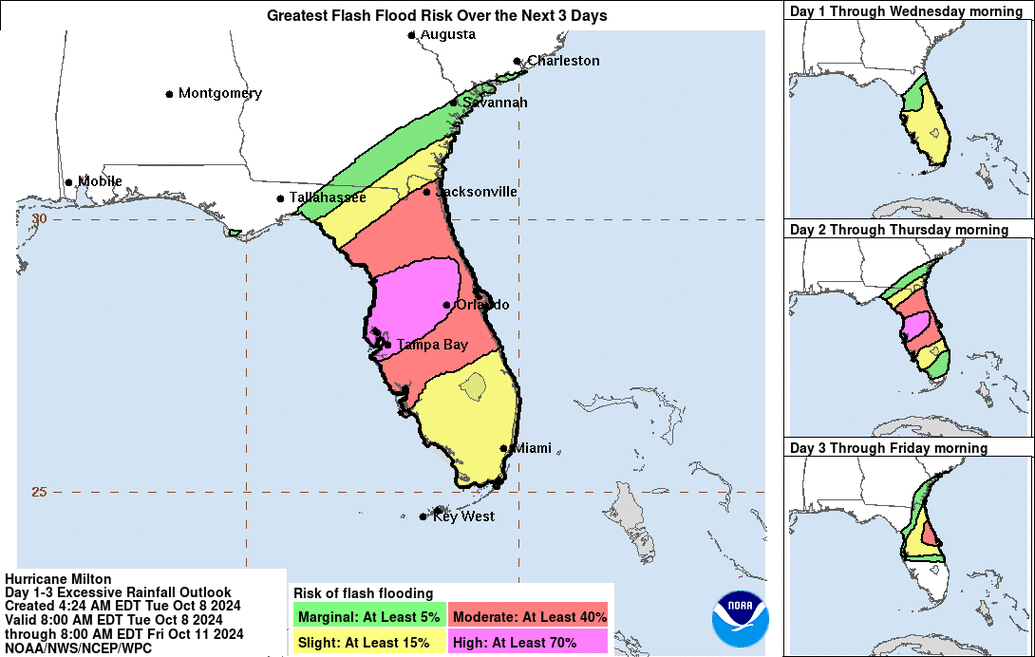Florida-bound Hurricane Milton’s top wind speed slowed to 155 miles per hour in the early morning hours Tuesday, and the storm dropped to an “extremely powerful” Category 4 hurricane, according to the National Hurricane Center (NHC).
Rain and wind from the storm began lashing Mexico’s Yucatan Peninsula on Tuesday, and it’s forecasted to head toward Florida on Wednesday.

A satellite view of Hurricane Milton in the Gulf of Mexico taken early Tuesday.
National Hurricane Center
“Milton is expected to grow in size and remain an extremely dangerous hurricane when it approaches the west coast of Florida on Wednesday,” said the NHC, in an advisory issued Monday evening. “A large area of destructive storm surge will occur along parts of the west coast of Florida. This is an extremely life-threatening situation and residents in this area should follow advice given by local officials and evacuate immediately if told to do so.”
The risk posed by Milton is especially dire since the storm is potentially poised to be the first hurricane to directly hit the Tampa metro area, which now has a population of 3.3 million, since 1921.
The storm is on track to cross over central Florida, passing over the Orlando metro area—home to millions—and into the Atlantic Ocean after making landfall on the state’s west coast.

The National Hurricane Center’s forecasted trajectory for Hurricane Milton.
National Hurricane Center
“Please, if you are in the Tampa Bay area, you need to evacuate,” Kevin Guthrie, the Florida Division of Emergency Management director, pleaded at a briefing on Monday. “Drowning deaths due to storm surge are 100 percent preventable if you leave.”
Tampa Mayor Jane Castor was blunt in her assessment during a Monday night appearance on CNN: “I can say without any dramatization whatsoever: If you choose to stay in one of those evacuation areas, you are going to die.”
The evacuation areas in Tampa the Mayor referred to are mostly in neighborhoods along the city coastline, and also impacts the Tampa International Airport and MacDill Air Force Base—the airport will shut down from 9 am Tuesday, while the U.S. Air Force began evacuating planes and personnel from MacDill on Monday.
Public schools in the Tampa area will be closed for most of the week, according to officials for the affected counties.
A report by a catastrophe risk assessment firm in 2015 concluded that Tampa was the most vulnerable metro area in the U.S. because half of the population “lives on ground elevations less than ten feet” and the topography of the coastline means “Tampa Bay creates a large funnel—particularly for a hurricane with its radius of maximum winds near the mouth of the bay. A severe storm with the right track orientation will cause an enormous buildup of water that will become trapped in the bay and inundate large areas of Tampa and St. Petersburg.”

A highlighted map shows mandatory evacuation zones, in red and orange, in Tampa ahead of Hurricane Milton’s forecasted landfall.
City of Tampa
Traffic cameras on Interstate 4 showed bumper-to-bumper traffic leaving Tampa on Monday.
Scientists expect Milton will continue to weaken slightly before landfall, but to arrive in central Florida as a Category 3, potentially causing severe damage and disruption to a southeast region already devastated by Hurricane Helene, which killed over 230 people last week.
The NHC forecast for rainfall ranges from five to 10 inches across Florida, with some heavily impacted areas potentially seeing as much as 15 inches. Even with diminished wind strength, Milton could still do damage to homes and power infrastructure.

A graphic showing flash flood risks posted by Hurricane Milton across Florida.
National Hurricane Center
The Walt Disney World Resort southwest of Orlando said as of Monday night that it will remain open. However, it is planning temporary closures of several sites at its Saratoga Springs Resort & Spa, including its Fort Wilderness Resort & Campground, Copper Creek Cabins, and Treehouse Villas. They are expected to remained closed until the weekend.
Unlike Disney World, the Orlando airport plans to close itself off to commercial operations beginning Wednesday. Orlando area public schools and universities are also planning closures.
Florida Gov. Ron DeSantis, who has declared a state of emergency in 51 counties, said electricity outages are likely. Shares in the backup power generator manufacturer Generac Holdings surged 8.5 percent on the New York Stock Exchange Monday, while shares in insurance providers Allstate, Travelers, and Chubb fell more than 4 percent.
Milton will cause an estimated $60 billion to $80 billion in damage and losses, said Chuck Watson of Enki Research, which designs computer models of weather phenomena.
The White House said Monday evening that President Joe Biden had calls with DeSantis and Castor “to get a firsthand report on recovery efforts for Hurricane Helene, and to discuss preparations for Hurricane Milton. He asked the Governor and the Mayor to call him directly if there is anything that can be done to further support the response and recovery efforts.”











